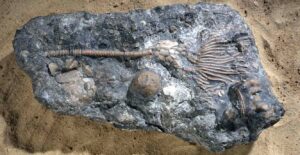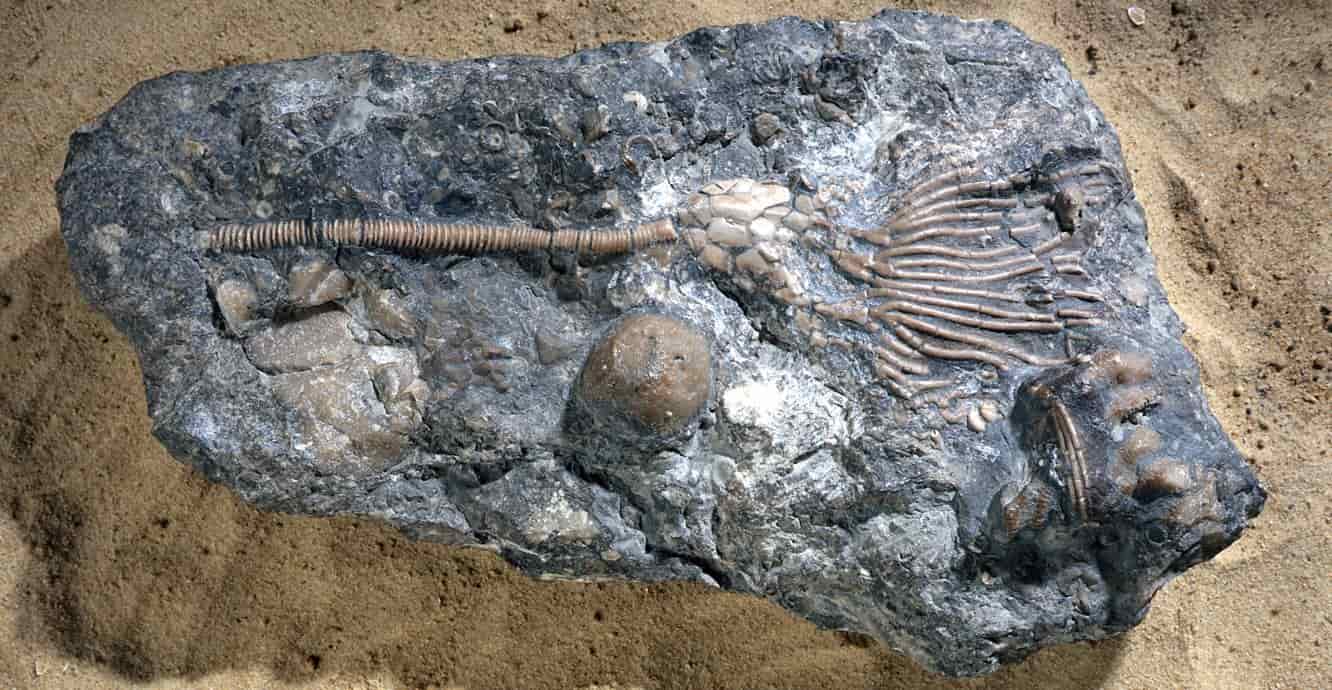
Introduction about Crinoids
What Are Crinoid Fossils?
Crinoids, also known as sea lilies or feather stars, are a group of marine animals that belong to the phylum Echinodermata. These creatures have been around for more than 500 million years, and they play an important role in the marine ecosystem. They are filter feeders, using their feather-like arms to capture plankton and other small organisms.
One of the interesting things about crinoids is that they have a complex anatomy that can be preserved in fossil form. The stem of a crinoid is made up of many small plates called ossicles, which are connected by flexible ligaments. The crown of the crinoid, which contains the feeding apparatus, is made up of a series of arms that are covered in small pinnules. These pinnules are used to capture plankton and other small organisms and bring them to the mouth of the crinoid.
Fossil crinoids come in many different shapes and sizes. Some crinoids have long, slender stems, while others have short, squat stems. The crowns of crinoids can also vary in shape and size, with some crowns being very small and others being quite large.
Where are crinoids found?
Fossil crinoids are often found in sedimentary rocks, which form when layers of sediment are deposited and compressed over time. These rocks can be found all over the world, and they can provide valuable information about the history of life on Earth. Fossil crinoids have been found in rocks dating back to the Ordovician period, which began around 485 million years ago.
In this article, we will explore some of the largest fossil crinoids ever discovered, including their size, location, and significance.
Taxocrinus saratogensis
One of the largest fossil crinoids ever discovered was found in the state of Indiana in the United States. The crinoid, which belongs to the species Taxocrinus saratogensis, was discovered in 1906 by a team of geologists led by John M. Clarke. The specimen is estimated to be around 350 million years old and is believed to have lived during the Devonian period.
The crinoid is incredibly large, with a stem measuring more than 40 feet in length and a crown that measures more than 10 feet in diameter. The entire specimen is estimated to have weighed more than 10 tons when it was alive. This makes it one of the largest fossil crinoids ever discovered.
The discovery of Taxocrinus saratogensis was an important event in the history of paleontology. At the time, it was the largest fossil crinoid ever discovered, and it provided valuable information about the morphology and biology of these ancient creatures. Today, the specimen is housed at the American Museum of Natural History in New York City.
Uintacrinus socialis
Another large fossil crinoid was discovered in the state of Missouri in the United States. The crinoid, which belongs to the species Uintacrinus socialis, was discovered in the early 20th century. The specimen is estimated to be around 300 million years old and is believed to have lived during the Carboniferous period.
The crinoid is also quite large, with a stem measuring more than 30 feet in length and a crown that measures around 6 feet in diameter. The entire specimen is estimated to have weighed more than 5 tons when it was alive.
The discovery of Uintacrinus socialis was significant because it provided valuable information about the evolution of crinoids. This species had a unique morphology that differed from other crinoids, and its discovery helped scientists to better understand the diversity of these ancient creatures.
Marsupitsa fragilis
In addition to the two specimens mentioned above, there have been many other impressive fossil crinoids discovered around the world. One of these is Marsupitsa fragilis, which was discovered in the United Kingdom in the 19th century.
The crinoid, which is estimated to be around 350 million years old, has a stem measuring around 20 feet in length and a crown measuring around 3 feet in diameter. The specimen is notable for its delicate and intricate morphology, which has been well-preserved in the fossil record.
The discovery of Marsupitsa fragilis was significant because it provided valuable information about the diversity and complexity of crinoids during the Devonian period. This species had a unique morphology that differed from other crinoids, and its discovery helped scientists to better understand the evolution of these ancient creatures.
Pachylocrinus nodosus
Another large fossil crinoid was discovered in the state of Texas in the United States. The crinoid, which belongs to the species Pachylocrinus nodosus, was discovered in the early 20th century. The specimen is estimated to be around 90 million years old and is believed to have lived during the Cretaceous period.
The crinoid is quite large, with a stem measuring around 20 feet in length and a crown measuring around 3 feet in diameter. The specimen is notable for its robust and heavily armored morphology, which has been well-preserved in the fossil record.
The discovery of Pachylocrinus nodosus was significant because it provided valuable information about the evolution of crinoids during the Cretaceous period. This species had a unique morphology that differed from other crinoids, and its discovery helped scientists to better understand the diversity of these ancient creatures.
Agaricocrinus americanus
Agaricocrinus americanus is another large fossil crinoid that was discovered in the state of Indiana in the United States. The crinoid is estimated to be around 350 million years old and has a stem measuring around 20 feet in length and a crown measuring around 3 feet in diameter.
The specimen is notable for its unusual morphology, which includes a crown that is shaped like a mushroom. This morphology is quite different from that of other crinoids, and its discovery has provided valuable information about the diversity of these ancient creatures during the Devonian period.
Encrinus liliiformis
Encrinus liliiformis is a large fossil crinoid that was discovered in Germany in the 19th century. The crinoid is estimated to be around 180 million years old and has a stem measuring around 10 feet in length and a crown measuring around 2 feet in diameter.
The specimen is notable for its delicate and intricate morphology, which has been well-preserved in the fossil record. The discovery of Encrinus liliiformis was significant because it provided valuable information about the diversity and complexity of crinoids during the Jurassic period.
Bathycrinus giganteus
Bathycrinus giganteus is a large fossil crinoid that was discovered in the Pacific Ocean in the 20th century. The crinoid is estimated to be around 35 million years old and has a stem measuring around 10 feet in length and a crown measuring around 1 foot in diameter.
The specimen is notable for its unusual morphology, which includes a crown that is shaped like a basket. This morphology is quite different from that of other crinoids, and its discovery has provided valuable information about the diversity of these ancient creatures during the Paleogene period.
Isocrinus nicoletti
Finally, we come to Isocrinus nicoletti, another large fossil crinoid that was discovered in the state of Indiana in the United States. The crinoid, which is estimated to be around 350 million years old, has a stem measuring around 20 feet in length and a crown measuring around 3 feet in diameter.
The specimen is notable for its unusual morphology, which includes a long, slender stem and a crown that is divided into numerous branches. This morphology is quite different from that of other crinoids, and its discovery has provided valuable information about the diversity of these ancient creatures during the Devonian period.
Conclusion
In conclusion, the discovery of large fossil crinoids is a testament to the incredible diversity of life that has existed on Earth throughout its history. These ancient creatures provide a glimpse into the past and help us to better understand the evolution of life on our planet. As scientists continue to study these fascinating fossils, we can expect to learn even more about the history of life on Earth.











